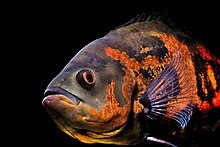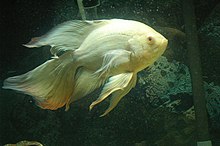Peacock cichlid
| Peacock cichlid | ||||||||||||
|---|---|---|---|---|---|---|---|---|---|---|---|---|

Peacock cichlid ( Astronotus ocellatus ) |
||||||||||||
| Systematics | ||||||||||||
|
||||||||||||
| Scientific name | ||||||||||||
| Astronotus ocellatus | ||||||||||||
| ( Agassiz , 1831) |
The peacock cichlid ( Astronotus ocellatus ) is a primeval appearing large cichlid from the Peruvian and Brazilian Amazon river system .
features
The peacock cichlid can reach a total length of up to 45 centimeters and a weight of about 1.5 kilograms. Its body is slender, slightly flattened on the sides and oval. The head is blunt and has a very large mouth with pronounced lips. The lower jaw protrudes.
The dorsal fin has 11 to 14 hard and 19 to 21 soft rays, the anal fin has three hard and 15 to 17 soft rays.
The body of the peacock-eye cichlid has a dark green to gray basic color. From the middle of the body to the abdomen and chin area, the body is covered by irregular spots and stripes that can be reddish brown to shiny orange-red in color. The unpaired fins can be lined with reddish to orange-red. At the base of the dorsal fin there may be black eye spots of different sizes with a light border . In the upper part of the tail fin base is a distinctive, mostly red or orange-red rimmed eye spot, the eponymous "peacock eye".
Astronotus ocellatus is one of the chaetobranchins cichlids because it has significantly enlarged micro- gill rakes. Its jaws are strongly toothed and surrounded by strong muscles. This indicates that fish and snails are the main diet.
Occurrence
The peacock cichlid is a South American freshwater fish native to the Amazon region . Here he lives in the Río Paraná , the Amazon, the Río Ucayali , the Rio Solimões , the lower Tocantins , the upper Madeira and Paraguay basins, the Orinoco , the Rio Branco , Guyana and French Guiana . He was also naturalized in Florida , Central America and some islands in Oceania . This species of cichlid prefers calm, stagnant waters, which is why they often stay in dead branches of the rivers, which are only connected to the large rivers during the rainy season.
Reproduction
Peacock cichlids are pair-forming substrate spawners . Their up to 2000 millet grain- sized eggs are yellowish and lose their color after about a day. The larvae that hatch after two to three days are relatively small and have three head glands with whose sticky secretion they can hold onto substrates when they are caught in the water current. The larvae swim free after about five days and develop quickly. A specialty of all Astronotus is the youth dress with whitish stripes on a chocolate brown background.
Systematics
Agassiz described this cichlid as Lobotes ocellatus in 1831 because he mistakenly thought it was a marine fish (see Lobotidae ). For this reason, no type locality is known. The holotype deposited in the Zoological State Collection in Munich was lost in the Second World War .
Until the Swedish ichthyologist Sven Kullander dealt with these fish, it was assumed that Astronotus was a monotypical genus, the only species of which after Agassiz had been described several times by other authors. However, Kullander shows that the genus has several species, some of which have not yet been described. However, so far only Astronotus ocellatus and the genus type Astronotus crassipinnis have been scientifically recognized (Heckel 1840).
Because of this, it is very difficult to correctly identify living specimens. The individuals depicted in this article cannot be reliably assigned either.
Importance to humans
Large cichlids are important and regularly fished food in their home areas. In addition, since their first import - in 1929 by the animal trading company Scholze & Poetzschke, Berlin - peacock cichlids have been popular aquarium fish with lovers of large cichlids who are mainly organized in the German Cichlid Society (DCG). Different colored and veil-fin cultivated forms have existed since the 1970s.
literature
- WE Engelmann: zoo animal husbandry - animals in human care - fish. Verlag Harri Deutsch, 1st edition, 2005.
- R. Stawikowski, U. Werner: The cichlids America I . 1998.
- W. Staeck, H. Linke: American Cichlids II - Large Cichlids - A manual for identification, care and breeding . 1992.
- KH Lüling: South American fish and their habitat . 1973.
- S. Hutchinson, C. Gsänger, G. Lehari, R. Weinberger: The encyclopedia of fish . 2008.
- Günther Sterba : The world's freshwater fish. Urania, Leipzig / Jena / Berlin 1987, ISBN 3-332-00109-4 .
Individual evidence
- ^ Kullander, SO (1986): Cichlid fishes of the Amazon River drainage of Peru . Swedish Museum of Natural History. 1-431.
Web links
- Peacock cichlid on Fishbase.org (English)




